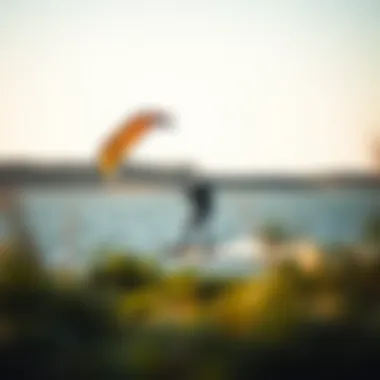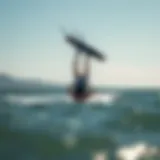Crafting Kites: Mastering the Art of Kite Making


Intro
Creating a kite isn’t just about throwing together some fabric and sticks; it’s an art, a dance between creativity and engineering. Kite making interweaves science with aesthetics. With the right choices in materials, design, and construction techniques, the dream of soaring high can transform from mere theory to a visible reality in the sky.
Understanding the complexities of kite crafting brings forth several layers to contemplate. Whether you’re a seasoned kiteboarder or just stepping foot into this exhilarating sport, the intricacies of how your kite performs play a pivotal role in shaping your experience. This exploration will take us through the methodologies of creating kites, helping you navigate through a field that can often resemble a windy maze.
As we embark on this journey, we’ll lay out comprehensive gear insights, delve into techniques and tips for both novice and veteran kite crafters, and tackle the nitty-gritty of safety practices. Pay special attention to every detail. The impacts of environmental factors, material choices, and design principles could very well dictate whether your kite flies gracefully or flops disappointingly.
In the world of kiteboarding, the right gear can make or break your adventure. Through insightful gear reviews and practical advice aimed at enhancing your kiteboarding experience, we’ll ensure you’re well-equipped to take on the winds. Create and customize your own kites while dodging common pitfalls that often plague beginners. So, hold tight as we take this deep dive into the enchanting, albeit complex, world of kite creation.
Prelude to Kite Design
Kite design isn’t just a fancy term thrown around at hobby shops. It’s the backbone of kite crafting, deeply entwined with both the functionality of kites and the artist's vision. A well-designed kite not only captures the essence of artistic expression but also responds effectively to the elements, ensuring enjoyment for those who dare to fly them. Delving into this realm involves understanding various aspects, from the kite's shape and size to its material choices, all of which play a critical role in performance and durability.
Crafting a kite invites a unique blend of science and art, where aerodynamics meets creativity. This combination shapes peerless experiences for kiteboarders, travelers, and hobbyists alike. Knowledge about kite design can significantly alter how one interacts with winds and skies. Consider, for example, how different designs may perform in various wind conditions:
- Lighter designs often spin and dance elegantly, providing a graceful performance in gentle breezes.
- Sturdier, heavier kites hold their own in more turbulent winds, offering thrilling speed and stability.
In the realm of kiteboarding, this understanding can make all the difference. The benefits derived from knowledgeable kite design extend beyond mere aesthetics; they ensure kites fly higher and with greater control.
The Evolution of Kites
Kites have a storied history that stretches across centuries and continents. From their origins in ancient China, where they served both practical purposes and cultural significance, kites have transformed massively over time. Initially, they were crafted using simple materials, like bamboo and silk, representing more than just a child's plaything. The first kite’s purpose was often tied to military reconnaissance and communication, touching on the very fabric of human ingenuity.
As time marched forth, innovation ushered in an array of designs, materials, and uses. Kites began to embrace various shapes, from traditional diamond forms to the more popular delta designs used in modern kiteboarding. The introduction of synthetic materials like ripstop nylon revolutionized the craft, providing improved strength-to-weight ratios and durability.
Moreover, the advent of technological advancements, such as computer-aided design (CAD), has allowed for precise calculations in aerodynamics and performance, setting the stage for exceptionally engineered kites that perform impressively across a range of conditions. What once began as a humble piece of string and fabric has blossomed into an art form that interlinks creativity with scientific principles.
"Kites are more than just toys; they tell a story of artistry united with the laws of nature."
Purpose and Applications of Kites
The purposes of kites stretch far beyond the joy of watching them soar through the air. In the realm of sport, kites are pivotal for activities like kiteboarding and kitesurfing, where their design directly affects performance and rider experience. Their ability to harness wind power translates not only into fun but also into competitive edge. Understanding the application of kites opens up pathways to optimizing performance based on individual needs.
For hobbyist builders and enthusiasts, creating personalized kites can become a passionate pursuit. There's a unique satisfaction in watching a kite take on its identity in the air, often tailored to reflect personal style or achieve specific flying conditions. In educational settings, kites serve as a tangible tool to teach fundamental principles of physics, such as lift, drag, and thrust, making learning interactive and engaging.
Kites also find application in art and culture. They appear in festivals around the world, where they bring communities together, bridging differences through shared enjoyment. From competitive kite festivals to recreational family gatherings, the kite remains a symbol of freedom and connection, adaptable to various facets of life.
With such diverse applications and the melding of tradition with modernity, the conversation around kite design becomes ever more intricate, deserving of careful consideration for those looking to master the art of kite crafting.
Understanding Kite Anatomy
Understanding kite anatomy is a vital stepping stone for anyone interested in kite creation. When one can grasp the various components and their functions, it paves the way for more informed design decisions and enhances overall performance. This knowledge isn’t just beneficial; it's essential for crafting kites that can endure the rigors of the skies.
Why focus on kite anatomy? Essentially, knowing the anatomy of a kite helps in recognizing how each part works together to create lift, stability, and durability. This understanding affects every aspect of kite making, from choosing materials to altering designs for better performance under different wind conditions.
Basic Components of a Kite
Every kite, regardless of shape or size, is built from a few essential components. The key players in this construction include:
- Frame: The skeleton of the kite, usually made of lightweight materials like fiberglass or carbon fiber. The frame supports the fabric and gives the kite its shape.
- Sail: This is the fabric portion of the kite that catches the wind. Common materials include ripstop nylon or polyester, known for their strength and minimal weight.
- Tail: Not all kites require a tail, but those that do often use it to enhance stability. The tail helps balance the kite in the air, preventing it from spinning wildly.
- Bridle: This network of lines connects the frame of the kite to the lines used for flying. Proper bridle adjustment can be the difference between a kite that flies well and one that flops.
- Lines: These are the threads that connect the kite to the flyer and control its maneuverability.
A kite’s design heavily influences how these components interact. For instance, a larger sail means more surface area, which could lead to better lift but also requires a sturdier frame to withstand the increased forces of the wind.
Types of Kites and Their Functions
The variety in kite types reflects the myriad of activities they can support, from recreational flying to competitive racing. Here are some common types of kites and what makes them tick:
- Stunt Kites: These are designed for tricks and maneuvers. They typically feature two or more lines, allowing for better control and precision.
- Delta Kites: Recognizable by their triangular shape, delta kites are great for light winds and are quite stable in the air.
- Box Kites: With their three-dimensional structure, box kites can remain aloft in variable wind conditions, making them suitable for high-altitude flying.
- Traditional Kites: Often made of paper or fabric stretched over a frame, these kites serve as both art and amusement.
- Sport Kites: These are advanced kites designed for high-speed flying and acrobatic capabilities, often with advanced control systems.
"Each kite type serves its unique purpose and caters to a specific flying style. Understanding these distinctions helps in selecting the perfect kite for your needs."
When selecting a kite, consider not just how it looks, but also how its components will perform together. Different designs necessitate different components, and recognizing these relationships can drastically influence your crafting experience and ultimately, your flying enjoyment.
Materials for Kite Making
In the world of kite creation, selecting the right materials is not merely a step; it’s a foundation. The choice of materials drastically affects the kite’s performance, longevity, and overall flyability. A kite constructed with quality materials can mean the difference between a remarkable flying experience and a flimsy display that barely soars. Therefore, understanding the nuances of various materials is imperative for kiteboarders and hobbyists alike.
Durability and performance of kites rely significantly on whether the maker chooses appropriate fabrics and structural components. High winds can quickly shred poorly crafted kites, while the right materials offer resilience against mother nature’s unpredictability. Moreover, certain materials provide unique benefits, from lightweight performance to enhanced stability, making the kite responsive in various wind conditions. Knowing the strengths of each option helps in crafting kites that are not only functional but also enjoyable to fly.
Choosing the Right Fabric
When it comes to choosing fabric for your kite, the options are as varied as they come. Ripstop nylon and polyester are two of the most popular choices. While ripstop nylon is lightweight, strong, and can handle a good amount of abuse, polyester typically holds color better and is less prone to fading in the sun. This makes it important for kiteboarders who spend hours beneath bright skies.


It's critical to consider the denier of the fabric, which indicates thickness. A higher denier number denotes a more robust fabric that can weather tough conditions. Moreover, breathability of the fabric ensures that air can fill the kite effectively, enabling smoother flight patterns.
A useful tip when selecting fabric is to also think about the weight of the fabric in relation to the size of your kite. Larger kites may benefit from sturdier materials, while smaller kites often perform best with lighter fabrics to keep them agile in the air.
Durability versus Weight: A Material Balance
The balance between durability and weight is a constant juggle in kite design. On one hand, you want your kite to be able to withstand strong winds; on the other, it’s no good if it’s so heavy that it struggles to lift off. Achieving the right equilibrium is often a matter of experience and understanding.
- Heavier materials are great for robust kites that can endure rough flying conditions but make them sluggish in lower winds.
- Lighter materials, however, provide agility and height in low winds but might compromise on durability, especially during harsh landings or unexpected gusts.
When embarking on a kite-making adventure, consider the conditions you’ll be flying in most often. For instance, a kite designed for light, breezy days in coastal regions may prioritize lightweight materials, while a kite intended for turbulent mountain valleys needs thicker, durable components.
Ultimately, a kiteboarder must assess their individual needs, weather patterns, and their own skill level before deciding on material for their kite. This thoughtfulness can elevate a simple flying experience into an art form that aligns performance with pleasure in every exhilarating flight.
"The choice of materials is not just about functionality; it's about crafting an experience that resonates with the spirit of flying."
For more insights into fabric technology, look into resources like the American Kitefliers Association or explore forums on sites like Reddit.
Useful References
Blowing Up Kites: Techniques and Considerations
Blowing up kites properly is not just a critical step in the kite-making process; it's an art form that significantly impacts the kite's performance and durability. Understanding the intricacies behind this process allows both amateurs and seasoned kite creators to lift their craft off the ground efficiently. Getting it right can mean the difference between a smooth ride and a mid-air disaster, so let’s dive deep into the techniques and considerations that every kite enthusiast should keep in mind.
Inflatable Design Basics
The heart of a kite's functionality lies in its design, particularly when it comes to inflatable kites. These kites utilize air to maintain their shape, which makes understanding inflatable design pivotal in kiteboarding.
Key elements of inflatable kite design include:
- Chambers and Segments: Kites are divided into multiple chambers, each filled with air, allowing for controlled inflation. This segmentation distributes stress evenly, enhancing stability.
- Leading Edge Inflatable (LEI): A common design that utilizes a rigid leading edge that inflates fully to create a robust structure. A well-inflated LEI ensures that the kite flies efficiently even in varying wind conditions.
- Valves: The types of valves installed on the kite can affect the rate of inflation. Knowing how to operate these valves is crucial to achieving optimal air pressure.
Best Practices for Blowing Up Kites
Once you’re familiar with the designs, it’s time to put theory into practice. Here are some best practices for inflating kites that you should adhere to:
- Check for Damage: Before inflation, inspect the kite for any signs of wear or tear. Even a small puncture can lead to catastrophic failure in flight.
- Choose the Right Environment: Inflate kites in a calm area, free of debris that might damage the fabric. Winds should be mild—overinflating in strong winds can deform the structure of the kite.
- Use a Pump: A quality pump that matches your kite's valve will save time and effort. Manual and electric pumps both have their advantages; choose what aligns with your needs.
- Monitor Pressure: While inflating, maintain attention to the pressure gauge. Overinflation can lead to early wear and decreased lifespan, while under-inflation can result in poor performance in the air.
Common Pitfalls When Inflating Kites
Despite careful preparations, inflating kites is not without its challenges. Recognizing common pitfalls can help avoid mistakes:
- Overlooking Air Leaks: Air leaks can occur around valves. A simple test is to inflate the kite and listen for escaping air. Tighten the valve if you hear any hissing.
- Inadequate Inflation: Many novice kite users assume that an average level of inflation is sufficient. This could lead to poor lift and control, making it hard to navigate.
- Ignoring Temperature Effects: Temperature plays a crucial role in inflation. Cold air is denser and will take more effort to fill the heart of the kite. Conversely, hot air can expand, putting additional stress on your seams.
"A kite isn't just a piece of fabric; it's a carefully balanced machine. Understand each element, and your experience will soar."
By paying attention to these techniques and considerations, kiteboarders can enhance both the safety and enjoyment of their kiteboarding adventures. Proper blowing up techniques will ensure that your kite not only flies well but provides a reliable experience throughout its lifespan. For more resources on kite making and usage tips, check out links from Wikipedia and Britannica.
As you navigate the interplay of design, technique, and environmental factors, your kitecrafting skills will take flight, transforming each outing into a memorable journey.
Aerodynamics of Kites
Understanding aerodynamics is not just vanity; it’s the backbone that holds everything together in the world of kites. The way kites interact with the wind determines their performance and ensures that they can soar to great heights—or fall flat. When one dives into kitecraft, being well-versed in aerodynamics not only elevates the quality of the kite but can also result in significantly enhanced flying experiences for enthusiasts.
Understanding Airflow and Lift
Airflow and lift are the yin and yang of kite flying. Lift is produced when the airflow separates over the top surface of the kite, creating a difference in pressure between the top and bottom surfaces. This phenomenon is fundamental; without it, well, you might as well be flying a piece of cardboard.
To grasp airflow, one must consider a few key factors:
- Angle of Attack: The angle at which the kite meets the wind is crucial. An angle that is too steep can cause stalling, while a shallow angle may not yield adequate lift.
- Wing Shape: The design of your kite also plays a significant role. Kites with a curved surface can better manipulate airflow. For example, delta shape kites, with their pointed tips, can generate lift more efficiently than flatter styles.
This understanding of how air flows over the kite allows builders to design more effective kites. It's truly a balancing act; too little lift and the kite barely leaves the ground, too much tilt causes it to nosedive. So, it’s essential to play around with different designs and angles until you strike the right balance.
Impact of Design on Performance
You could have the finest materials known to humankind, but if your design is off, your kite might as well be made of spaghetti. Design encompasses everything from the shape, size, and material down to the detailing of bracing and how all the components fit together.
When looking at the impact of design:
- Shape Variability: Innovative shapes can enhance lift, stability, and maneuverability. Understanding specific kite shapes allows builders to tailor their creations to specific wind conditions and user preferences.
- Material distribution: The right distribution of weight can influence how a kite performs in the air. A kite that’s bottom-heavy will behave differently than one with a top-heavy design. Properly distributing materials can drastically improve the kite’s aero qualities.
- Stress Points and Structural Integrity: Kites must endure wind pressures; hence, having proper reinforcement in key stress points is paramount. Failure to consider these factors can lead to fractures or unexpected breaks mid-flight, inciting chaos among the skies.
Investing time into studying aerodynamics and how design affects performance makes all the difference. Taking a little time to get the hang of these concepts will enhance not only the kite-building experience but also add new dimensions to how one enjoys kite flying.


"Great designs consider not just what is aesthetically pleasing, but what's productive in air and movement."
For further reading on aerodynamics and kite designs, check out resources like Britannica or delve into the discussions on Reddit's Kiteboarding Community.
Embracing these fundamentals opens up a vast world of possibilities, allowing for innovative designs and thrilling experiences. The sky truly is the limit with a keen understanding of aerodynamics.
Safety Protocols in Kite Production
When it comes to kite production, the importance of safety protocols cannot be overstated. Muddling through the intricate process of creating kites goes beyond mere aesthetics and functionality; it includes a comprehensive layer of safety considerations that protect both the kite maker and user. The nature of kiteboarding invites challenges—unpredictable wind patterns, varying degrees of material strength, and the necessity for stable designs. Therefore, adhering to safety protocols saves time, resources, and potentially accidents.
A robust safety protocol includes understanding risks, managing hazards, using proper techniques for construction and inflation, and selecting appropriate materials that ensure both functionality and safety. Consequently, this not only enhances the overall kiteboarding experience but also builds a foundation of trust among enthusiasts, instructors, and manufacturers alike.
Preventing Accidents During Inflation
Using kites involves various risks, especially during the inflation process, when the structure is first filled with air and gains its shape. This moment is critical, as improper inflation techniques can lead to damage or accidents. Here are several practices that must be ingrained in every kite maker's routine to minimize these risks:
- Stable Launch Area: Always inflate kites in spacious environments free from obstacles. This reduces the chance of encounters with trees, power lines, or other dangerous items.
- Secure Anchoring: Before inflating, ensure that the kite is anchored adequately. Whether using weights or securing it with a buddy—this step keeps the kite stable during the filling process.
- Controlled Wind Awareness: Understanding wind conditions is key. Avoid inflating kites in strong gusts, as these can unpredictably lift the kite, potentially leading to injury or accidents.
It's imperative to train oneself and others on these best practices, establishing an environment where safety is clear and priority.
Materials That Ensure Stability
The journey toward kite safety greatly depends on the right materials—after all, a stable kite starts with a thoughtful choice of resources. Kite material influences not only performance but safety as well. In this regard, specific materials are recommended for their stability and durability:
- Reinforced Fabrics: Materials like ripstop nylon or polyester provide resilience against tearing while ensuring that the kite can withstand varying wind conditions.
- Sturdy Frame Materials: Utilizing fiberglass or carbon fiber poles aids in reinforcing the kite's structure. Their strength-to-weight ratio makes them ideal for ensuring that the kite remains stable and doesn't warp under pressure.
- Secure Joining Mechanisms: Employing high-quality clips, knots, and adhesive tape can bolster the integrity of the kite. Double-checking these connections ensures that all components are secure during flight.
Selecting materials that maximize safety alongside aerodynamics is fundamental. Thus, every kite creator must be attuned to the implications their material choices might have, translating care and prudence into an enriching kite-experience for both users and creators.
"Safety is not just a protocol, it's a way of thinking. We design with care to fly without fear."
By embracing these safety protocols, kite makers can effectively foster an environment of safety, enhancing the overall experience while minimizing potential issues. An informed approach to each phase of kite production creates a communal atmosphere where all can enjoy the kiteboarding adventure with confidence.
For further insights on kite safety, you might find these resources helpful: Wikipedia - Kites, National Institute for Occupational Safety and Health.
Environmental Factors Affecting Kites
Kite performance hinges not just on the craftsmanship behind it but also significantly on environmental elements. Understanding these factors is vital for anyone looking to excel in kiteboarding. A kite’s ability to soar or flop can often be traced back to how well its creator accounted for wind conditions and temperature dynamics. It’s worth emphasizing that these elements can turn even the most meticulously crafted kite into a dud if overlooked.
Wind Conditions and Their Influence
Wind is the lifeblood of any kite. Variability in wind conditions can affect everything from lift to stability. It’s not simply about having a breeze; it’s about understanding the nuances of how that wind interacts with your kite.
- Direction: The direction of the wind greatly impacts how a kite behaves. Kites perform best when flown in a wind that is more or less aligned with their intended orientation. A crosswind may cause erratic movements, making handling tricky.
- Strength: The strength of wind plays a crucial role in kite choice. Light winds require kites designed for low lift, possibly those with larger areas to catch as much breeze as possible. On the other end, strong winds call for smaller, sturdier kites to prevent tearing and ensure control.
- Consistency: Steady winds are a kiteboarder's best friend. Variable gusts can send even seasoned flyers into a tailspin. It’s important to check forecasts for wind consistency to avoid disappointment on the beach.
"When in doubt, let the wind be your guide. A keen eye on the breeze can lead to countless successful flights."
- Terrain Influence: The surrounding environment can create unique wind patterns. For example, flying near cliffs or buildings may result in unexpected turbulence, affecting kite stability. Familiarizing oneself with local topography is thus essential.
Temperature Effects on Performance
Temperature is another environmental variable that must be acknowledged when crafting or flying kites. Contrary to what one might think, it's not just about comfort; temperature can significantly influence materials and, subsequently, performance.
- Material Expandibility: Most kite fabrics respond to temperature changes. In hotter conditions, materials can become more pliable, while cooler temperatures tend to stiffen them. Understanding how your chosen materials react can inform design decisions, especially for kites exposed to varying climates.
- Wind Density: Warm air is less dense than cold air. This density variation can affect lift. Kites may require specific adjustments in warmer conditions, as they may need slightly more wind to achieve optimal performance compared to cooler days.
- Breakdown of Adhesives: Temperature fluctuations can also weaken adhesives used in kite construction. In hotter climates, the high temperatures could lead to faster breakdown and subsequent failure, potentially compromising the structural integrity of the kite.
- Flight Duration: Warm temperatures can enhance the duration of a flight. When air is buoyant, it helps keep the kite aloft longer. This fact should motivate kite enthusiasts to seek ideal conditions, maximizing their outdoor experience.
In wrapping up this discussion, kite creators must consider temperature alongside wind to ensure consistent performance, mitigate risks, and extend the longevity of their creations. Every little bit matters when you're chasing the skies.
Common Mistakes in Kite Making
Crafting kites, while seemingly straightforward, is laced with potential pitfalls that can lead to frustration or a disappointing experience out in the field. Understanding the common errors made during the kite building process is essential for enthusiasts eager to glide easily through the skies with their creations. Shying away from these missteps not only enhances the performance of the kites but also deepens the pleasure derived from kiteboarding. Here, we’ll delve into two prominent mistakes—overlooking material quality and ignoring aerodynamic principles.
Overlooking Material Quality
When it comes to kite creation, the saying, "You get what you pay for," rings so true. Rushing through the choice of materials can lead to sub-par kites that are prone to tearing or failing mid-flight. Many novice kite makers believe that any fabric or plastic will suffice, but that's a misconception that can burn you in more ways than one.
The fabric and frame of a kite should be light yet robust, and quality needs to be prioritized. Heavy or inferior materials can weigh down a kite, making it sluggish or difficult to manage. On the other hand, high-performance fabrics like ripstop nylon or Polyester can offer strength without compromising weight, allowing kites to withstand wind pressure while maintaining agility in the air.
Paying heed to material specifics can seem nitpicky, yet it proves crucial. For instance, consider what might happen if you opt for a cheap fabric resistant to UV rays. The kite may quickly fade, lose structure, and ultimately, fail to captivate audiences overhead. Hence, before you pick up that bargain fabric, think about quality and performance.
Ignoring Aerodynamic Principles
Kite design is fundamentally predicated on the laws of physics, particularly when it comes to aerodynamics. For a kite to perform well, it needs to harness the wind efficiently, a concept too often overlooked by those new to making kites. Many simply focus on aesthetics, neglecting how the shape and size of the kite can impact its ability to catch and ride the air.
For instance, flat kites like delta or box kites are great for stability, while stunt kites require a more intricate design to function correctly. Failing to understand the airflow around your design can result in a kite that struggles to lift or control smoothly, leading to a frustrating experience on the water.
Designing for aerodynamics involves crafting a profile that maximizes lift while minimizing drag. It's beneficial to think of a kite as a finely tuned instrument. You wouldn't use a tuba in an orchestra and expect it to play like a violin! The same principle applies to kites; consider wind direction, shape, and size meticulously to create a well-balanced unit.


"A well-constructed kite flies beautifully, while a poorly designed one is nothing but a tangled disaster."
In summary, avoiding the mistakes of overlooking material quality and ignoring aerodynamic principles can significantly impact your kite-making journey. Knowledge empowers you to create kites that not only fly but soar. So, as you embark on your crafting endeavor, tread carefully through the design and material selection. A kite that dances gracefully in the sky is one that is born from careful thought and precise execution.
The Role of Innovation in Kite Design
In the ever-evolving field of kite making, innovation plays a crucial role. This aspect not only shapes the aesthetic appeal of kites but also enhances their performance in diverse conditions. The integration of modern technologies and innovative materials leads to kites that are more durable, more efficient, and offer tailored experiences for different users. Consequently, kite enthusiasts can enjoy an enriched experience, whether they are novices feeling the thrill of the skies or veterans seeking that edge in competitive settings.
Advancements in Materials Technology
The landscape of kite materials has seen remarkable advancements in recent years. Gone are the days when a simple paper or plastic would suffice. Nowadays, kite makers have access to a variety of high-performance fabrics designed to withstand challenging conditions while being lightweight enough for optimal flight. Materials such as Dyneema and ripstop nylon are commonly used due to their excellent strength-to-weight ratio.
The benefits of these advancements are manifold:
- Durability: Modern materials resist tearing and wear, extending the lifespan of kites significantly.
- Lightweight: Lighter fabrics allow for improved lift and maneuverability, enabling kites to stay aloft longer.
- Weather Resistance: Advanced materials can offer enhanced resistance to various weather conditions, making them suitable for a range of outdoor activities.
Such innovations also pave the way for the creation of specialized kites, like those used in competitive kite flying where precision and control are essential. When kites are made from top-notch materials, the results can be stunning both in the air and on the ground, attracting the attention of spectators and fellow kite enthusiasts alike.
Integration of Technology in Kite Creation
The marriage of technology and kite crafting is one of the most exciting developments in recent years. From computer-aided design (CAD) software to 3D printing, modern tools now allow kite makers to experiment with complex shapes and structures that would have been unimaginable just a couple of decades ago. This technology simplifies the development cycle, allowing for rapid prototyping and testing of new designs.
Additionally, there is an increased push towards incorporating electronic components into kites. Technologies such as lightweight sensors and GPS systems not only enhance flight dynamics but also enable a range of functionalities:
- Performance Monitoring: Sensors can track aspects like altitude, speed, and wind conditions, providing valuable data to kite pilots.
- Enhanced Control: Remote control systems can allow for greater manipulation and stability, especially in competitive environments.
"Innovation today is where beauty meets functionality, allowing kite makers to push the boundaries of what's possible."
The fusion of these technologies doesn’t just elevate performance; it opens the door to bespoke designs tailored to individual preferences and needs. Whether a kite is designed for casual fun or serious competition, innovation in technology ensures that kite enthusiasts can expect more exciting and personalized experiences.
Future Trends in Kite Production
As the world evolves, so does the art of kite making. For kiteboarders and enthusiasts alike, staying ahead of the curve in terms of trends is essential. The landscape of kite production is constantly being reshaped by technological advancements, environmental considerations, and evolving user preferences. Understanding these trends not only enhances kite performance but also deepens the engagement of users with the sport. The future of kite production holds promising developments in sustainability and personalization, making kites not just flying machines, but also reflections of individual style.
Sustainability in Material Choices
The conversation around sustainability has gained traction across many industries, and kite making is no exception. As consumers become more environmentally conscious, kite makers are turning their focus to sustainable materials. This shift is driven by several important factors:
- Biodegradable Materials: Innovations in biodegradable fabrics are emerging as a game changer. Materials like recycled polyester not only reduce waste but also offer excellent performance under diverse conditions. By utilizing these fabrics, kite makers confront the challenge of creating durable products while being kind to the planet.
- Recyclability: The construction of kites with materials that can be recycled contributes to a circular economy. Ensuring that kites can be remade or reprocessed at the end of their life not only minimizes waste but also aligns with the principles of sustainable cycling.
- Localized Production: Reducing shipping emissions by sourcing materials locally is gaining popularity. This not only supports local economies but lessens the environmental impact associated with long-distance transportation of kite materials.
Investing in sustainable practices doesn’t merely benefit the environment; it also appeals to a growing demographic of eco-conscious kite enthusiasts who care deeply about the impact of their hobbies. When kite makers align their production with sustainability, they enhance their brand image while promoting a greener future for the sport.
Potential for Personalization and Customization
Another head-turning trend in kite production is the emphasis on personalization and customization. Kiteboarders increasingly seek unique, individualized gear that reflects their personal styles and preferences. This inclination has led to several key developments:
- Custom Designs: Many manufacturers now offer options for custom graphics, patterns, and colors that dare to stand out from the mass-produced average. This can range from vibrant patterns to themed designs, allowing users to express their identities through their equipment.
- Adjustable Features: Innovations in adjustable kite sizes and designs pave the way for enhanced adaptability. Kites that allow users to modify their wing area or adjust the tension can lead to improved performance tailored to specific conditions, making each ride feel personal and unique.
- Community Collaborative Designs: Some brands are even tapping into the creativity of their communities by hosting design contests or collaborating with local artists. This not only fosters a sense of community among kite enthusiasts but also brings fresh ideas into kite designs.
The push for customization in kite production confirms a shift towards user-centered design. Enthusiasts want kites that not only perform well but also resonate with their individual taste, setting the stage for the next wave of innovation in the kiteboarding world.
"Embracing sustainability and personalization will shape the future of kite production, creating stronger connections between users and their kites."
For further reading on sustainability in material choices, check out Wikipedia or explore innovative designs through community platforms like Reddit.
By integrating these trends, kite makers can ensure they remain relevant and responsive to the evolving needs of kiteboarders in both the present and future.
Culmination and Recommendations
As we wrap up this exploration into kite creation, it’s essential to emphasize the significance of understanding the various elements that come into play in the crafting of kites. The process is not merely a pastime; it’s an intricate blend of artistry, science, and personal expression. Kite-making encapsulates a spectrum of skills and knowledge, from choosing the right materials to employing aerodynamics effectively in various conditions.
The recommendations outlined in this section serve not just as a capstone but as a roadmap for kite enthusiasts—whether you’re a novice or a seasoned pro. Here are a few key points to remember when venturing into kite production:
- Safety Comes First: Always prioritize safety. Equip yourself with the necessary gear and knowledge to mitigate risks. It’s better to be safe than sorry, especially when inflating or flying kites.
- Research Materials Carefully: The choice of fabric and structural components can significantly impact performance and durability. Invest your time in understanding various materials and their properties.
- Embrace Iteration: Don’t shy away from making mistakes. Each attempt adds to your experience, leading you to refine your designs and techniques.
- Stay Informed About Environmental Factors: Winds, temperature, and humidity can drastically affect kite performance. Keeping an eye on these factors ensures that you develop kites that function optimally in real-world conditions.
These recommendations holistically enhance the kite creation experience, turning potential frustrations into learning moments.
Summary of Key Insights
In this article, we've traversed multiple dimensions of kite creation:
- Kite Anatomy: A thorough understanding of components and their functions lays the groundwork for producing well-crafted kites.
- Material Selection: Different fabrics and their respective characteristics dictate the kite’s flight and longevity.
- Aerodynamics: Insights into airflow and lift provide the basis for improved design.
- Safety Protocols: A comprehensive safety strategy cannot be overstated; it’s integral for successful kite creation.
- Common Pitfalls: Recognizing frequent mistakes helps avoid them, streamlining the learning curve.
- Innovation: The adoption of new technologies and materials fosters enhanced performance and customization.
Each of these elements contributes to a larger narrative about kitecraft that encapsulates both technical skill and creativity.
Future Directions for Kite Enthusiasts
As the world of kiteboarding continues to evolve, several exciting trends and opportunities loom on the horizon:
- Sustainable Practices: The shift toward environmentally friendly materials is not just a passing trend but a necessity. Kite enthusiasts should look for eco-friendly options to minimize their environmental footprint.
- Personalization: Advances in manufacturing technology allow for unprecedented customization of kites. This trend enables enthusiasts to reflect their personal style and preferences uniquely.
- Digital Integration: The use of technology such as sensor data for performance analytics offers insights that were previously unattainable, enabling micromanaging of kite dynamics.
- Community Engagement: Expanding online forums and social media platforms like Reddit and Facebook allows kite enthusiasts to share knowledge, experiences, and tips. Collaborative learning is becoming a cornerstone of the kiteboarding community.
As kiteboarding garners more enthusiasts worldwide, the art of kite creation will continue to flourish. With each new trend comes the possibility of innovation and improvement in kite design.















